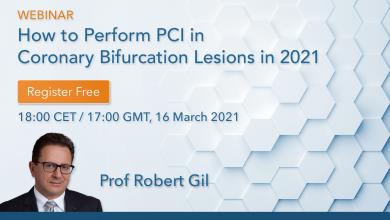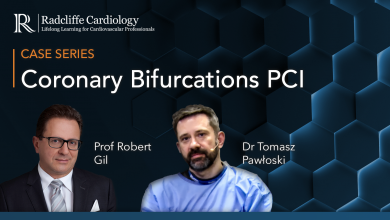Search results
Robert Gil
Research Area(s) / Expertise:
Job title: Head, Department of Invasive Cardiology, CSK MSWiA, Warsaw, Poland
Author
PCI in Coronary Bifurcation Lesions
Author(s):
Robert Gil
Start date:
Mar 16, 2021
Broadcast
Coronary Bifurcations PCI
Author(s):
Robert Gil
,
Tomasz Pawlowski
Added:
2 years ago
Video Series
TCT 23: IFR SWEDEHEART
Author(s):
Matthias Gotberg
Added:
5 months ago
Video
Author(s):
Barry Hennigan
,
Keith Robertson
,
Colin Berry
,
et al
Added:
3 years ago
The original studies of coronary balloon angioplasty performed by Andreas Gruentzig attempted to employ physiological guidance by measuring trans-stenotic gradients with over-the-wire angioplasty catheters.1 However, these catheters were of such large calibre that they contributed to the stenosis being assessed and in addition, measurements were made at rest as the importance of assessing…
View more
Author(s):
Sayan Sen
,
Justin E Davies
Added:
3 years ago
The use of physiology to guide revascularisation in patients with coronary disease has been demonstrated to improve clinical outcomes and reduce costs.1,2 Despite this, its adoption into clinical practice is very low,3 moreover, when it is employed it is used simplistically – only to determine if the vessel is ischaemic or not.
Recently, several new indices of stenosis severity have been…
View more
Author(s):
Davide Cao
,
Mauro Chiarito
,
Paolo Pagnotta
,
et al
Added:
3 years ago
The prevalence of concomitant coronary artery disease (CAD) in patients with severe aortic stenosis (AS) varies widely among different reports. This depends primarily on the definition used to assess CAD as well as study design and patient selection, therefore making a uniform estimate difficult. Major trials investigating transcatheter aortic valve implantation (TAVI) highlighted a substantial…
View more
Author(s):
Simon Kennon
,
Andrew SP Sharp
Added:
8 years ago
Update on iFR and FFR
Simon Kennon and Andrew Sharp at EuroPCR 2015
View more
Author(s):
Matthias Gotberg
Added:
2 years ago
In this short summary interview, Dr Matthias Götberg (Lund University, Lund, SE) discusses the five-year outcomes of a randomized trial of iFR-guided vs FFR-guided PCI (FR-SWEDEHEART). The study, presented at TCT 2021, demonstrated that the 5-year results of iFR-SWEDEHEART showed no difference in outcome at 5-years compared with FFR.
Discussion Points:
Importance of the study
Study design and…
View more
Author(s):
Ajay J Kirtane
Added:
6 years ago
In this video, Dr Ajay Kirtane discusses the question; 'Are You Surprised That DEFINE-FLAIR Showed That iFR Was Non-Inferior to FFR?'.
View more

















